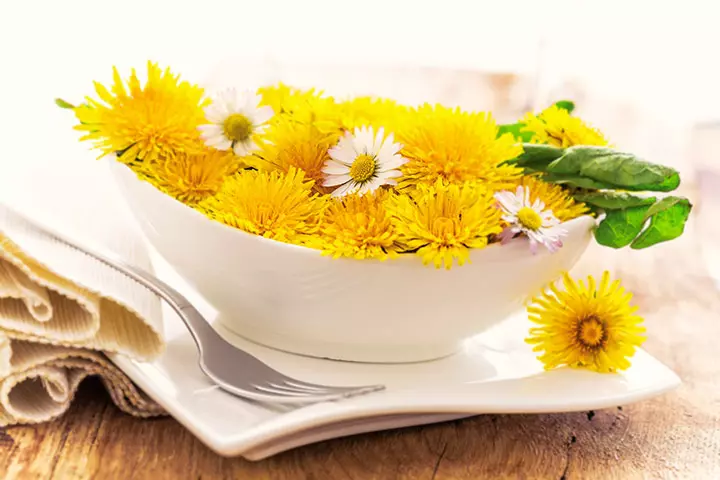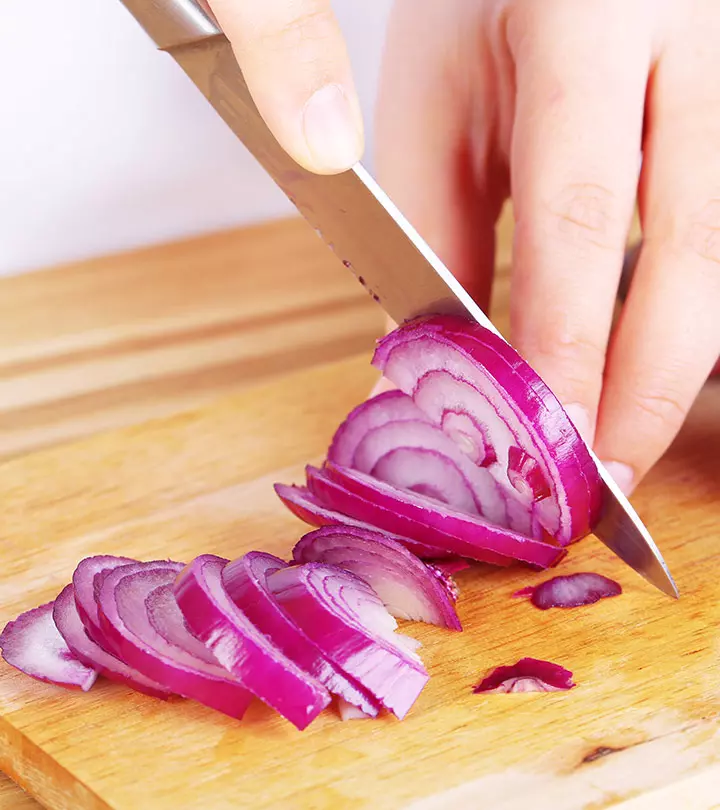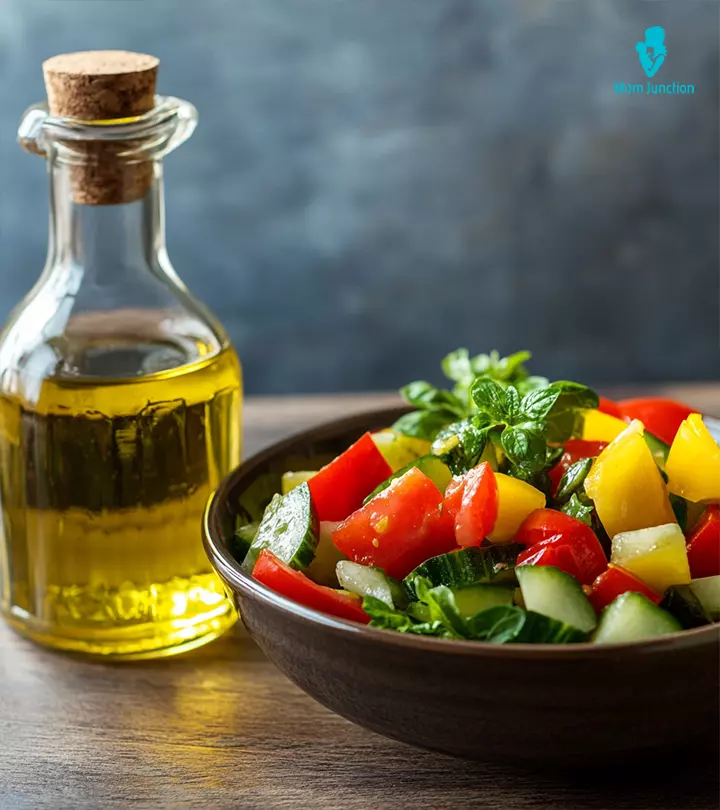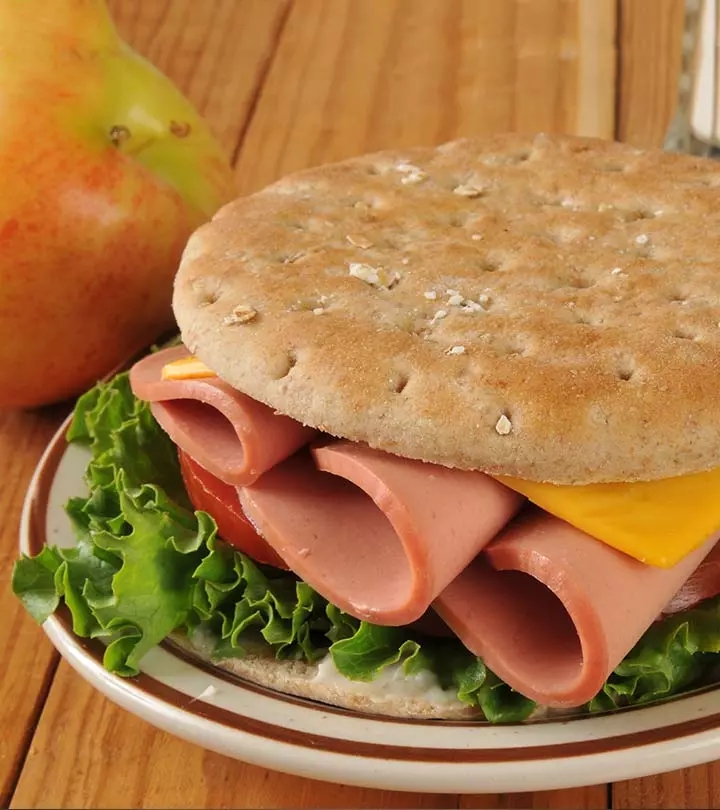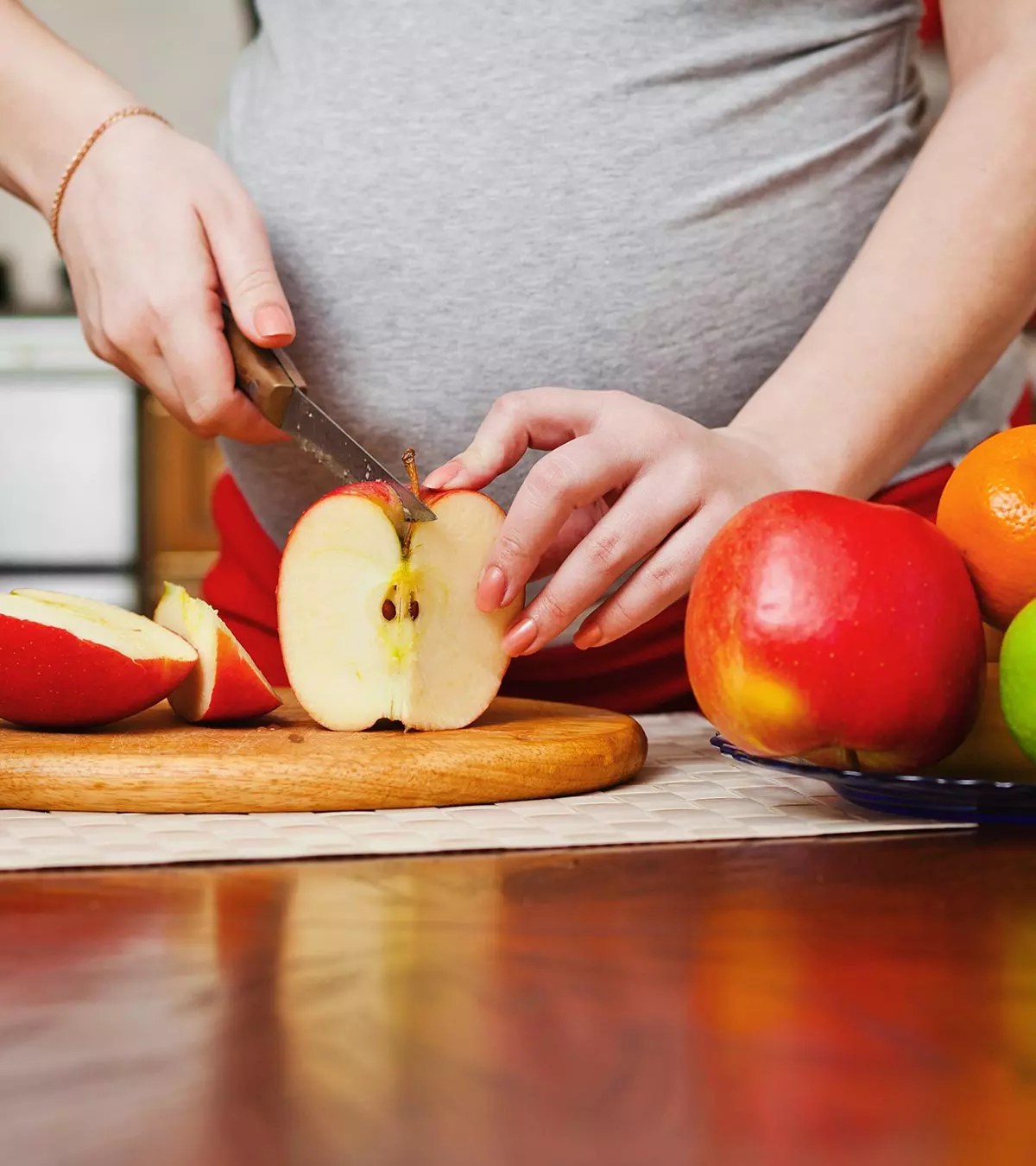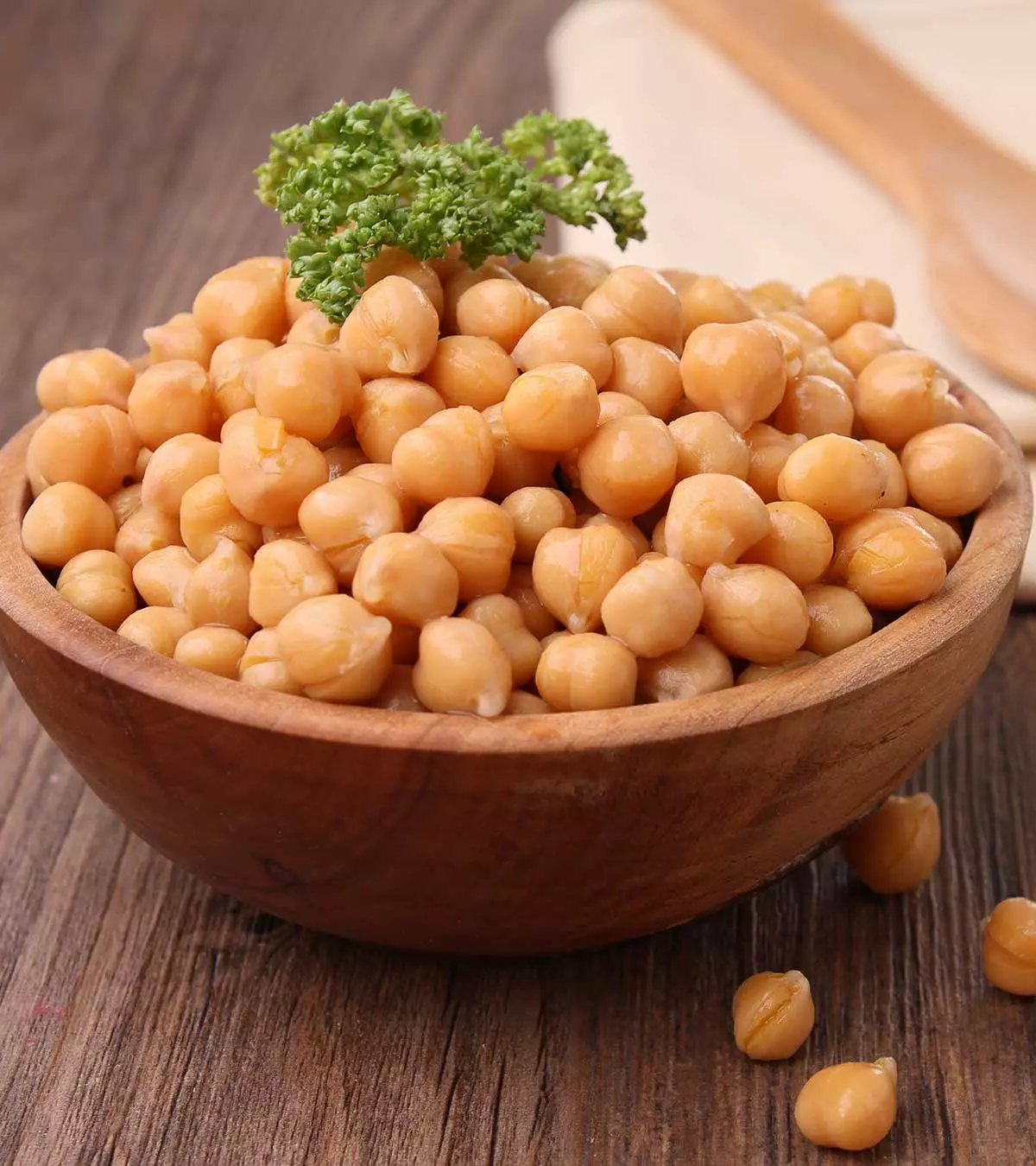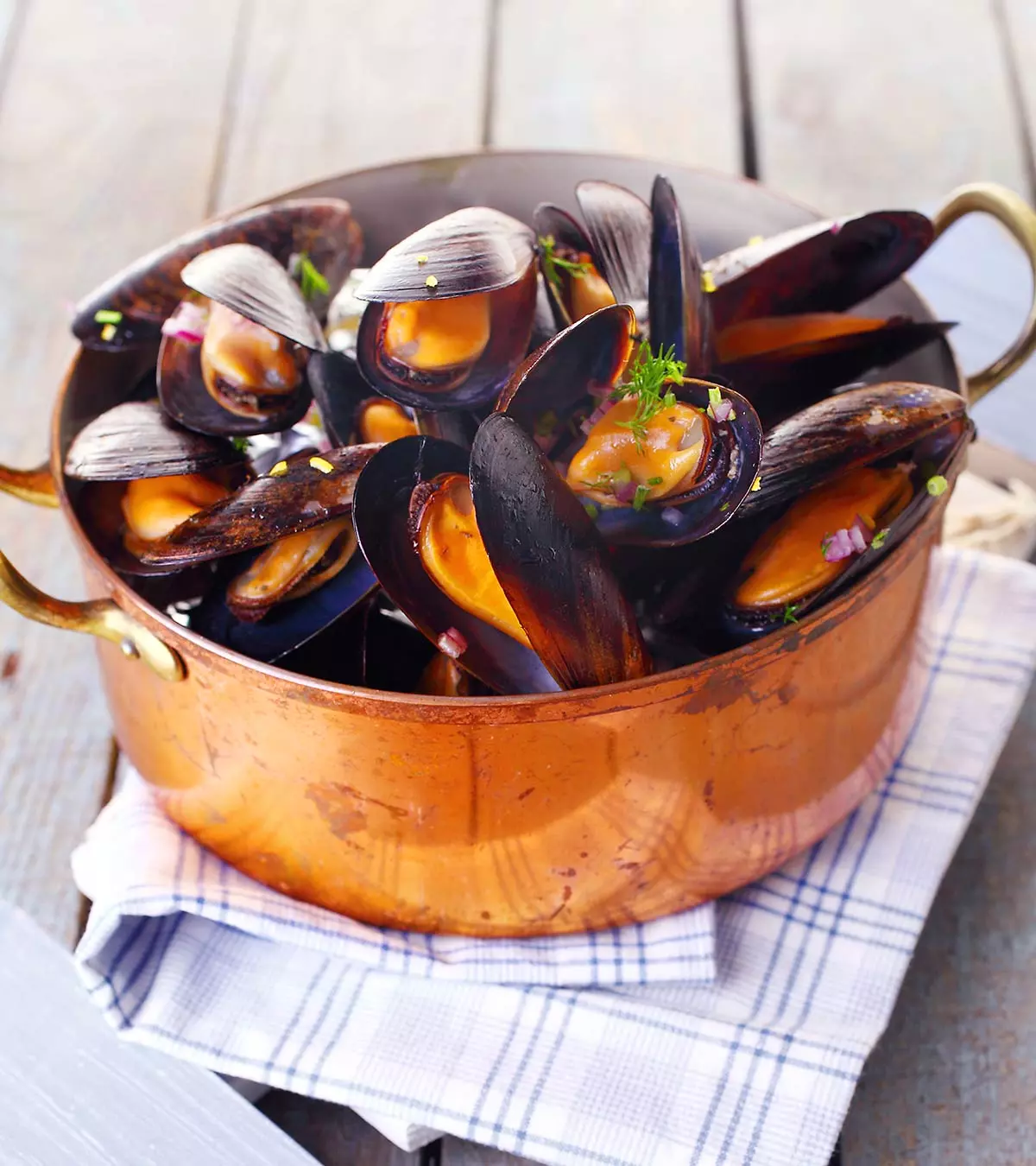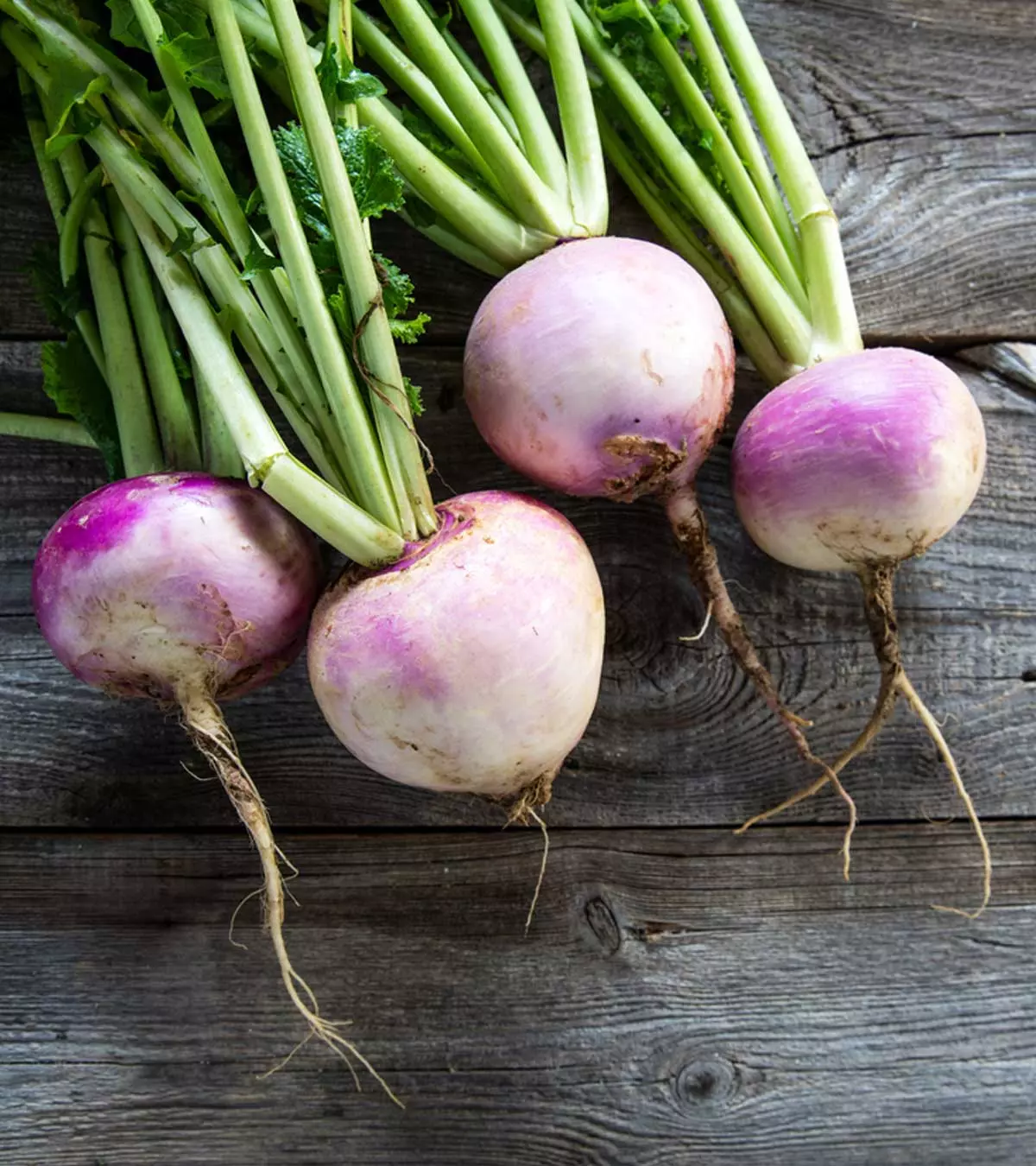
Image: iStock
Are turnips for babies a good choice? Let’s understand. Turnips are a type of root vegetable that is considered an essential part of a balanced plant based diet and are thus consumed worldwide. It is rich in micronutrients and fibers that help prevent signs of constipation in children (1).
However, the safety of turnips is at times questioned due to the presence of nitrates and nitrites in them. Read on to understand the benefits of turnips for children and their possible side effects.
Key Pointers
- Turnips are root vegetables abundant in micronutrients and fiber.
- They provide low calories and promote the growth and development of children when included in a well-balanced diet.
- Turnips Can be introduced moderately to solid food-eating infants in the form of puree or soups.
- Turnips support bowel regulation, improve iron absorption, enhance bone health, and have antioxidant and anti-inflammatory properties.
- Gastrointestinal disturbances, drug interactions, and allergic reactions are potential side effects of consuming turnips.
Can Babies Eat Turnips?
Yes, babies can eat turnip bulbs and turnip greens (fresh, green leaves) in moderate amounts as a part of a well-balanced diet and nutrition. Being a highly nutritious and low-calorie vegetable, turnips can support your baby’s growth and development.
Some people may avoid the vegetable for its nitrate and nitrite content. However, it is important to know that dietary intake of nitrate/nitrites in controlled amounts can be beneficial for health (2). Also, vegetables, such as turnips, are unlikely to expose the body to nitrate and nitrite levels that are harmful. It is the inorganic nitrates and nitrites found in fertilizers that usually are the cause of health issues associated with nitrate and nitrites (3).
When Can Babies Have Turnips?
Babies can start eating turnip bulbs and greens as soon as they start consuming solids, which is after the age of six months. However, parents might prefer to wait until their baby turns eight to ten months old. Babies at this age eat a wider variety of foods and may find it easier to digest turnips.
Nutritional Value Of Turnip
One cup (230g) of a cooked turnip mash (fresh) could provide the following nutrients as against the recommended values (4) (5) (6).
| Name | Amount | RDA |
|---|---|---|
| Water | 214g | – |
| Energy | 50.6Kcal | – |
| Carbohydrate, by difference | 11.6g | – |
| Fiber, total dietary | 4.6g | – |
| Sugars, total including NLEA | 6.83g | – |
| Calcium, Ca | 75.9mg | 270mg (7-12 months) |
| Magnesium, Mg | 20.7mg | 75mg (7-12 months) |
| Phosphorus, P | 59.8mg | 275mg (7-12 months) |
| Potassium, K | 405mg | 700mg (7-12 months) |
| Sodium, Na | 605mg | 200mg (7-12 months) |
| Zinc, Zn | 0.276mg | 5.6mg (7-12 months) |
| Vitamin C, total ascorbic acid | 26.4mg | 35mg (7-12 months) |
| Folate, total | 20.7µg | 32µg (7-12 months) |
| Choline, total | 19.8mg | 150 mg (AI) |
Sources: U.S. Department of Agriculture, World Health Organization, and National Institutes of Health
Turnip has several varieties,but the most common ones are the Purple Top White Globe, Tokyo, and Just Right (white) (7).
 Did you know?
Did you know?What Are The Health Benefits Of Turnips For Babies?
Apart from its cardioprotective effects that are attributed to the presence of nitrates, nitrites, and there are some more health benefits of turnip that are worth a check.
- Aids in bowel regulation: Turnip and its greens provide sufficient dietary fiber with water that is needed to regulate the baby’s bowel movement (8).
- Enhances iron absorption: Turnip greens contain a high amount of vitamin C. This vitamin enhances iron absorption (9).
- Contains prebiotics: The indigestible carbohydrate in turnip greens can act as prebiotics and support the immune system. Prebiotics in the gut could help promote gut microbes, which can help in the positive modulation of immunity (10).
- Can promote bone health: Turnip green is rich in vitaminK and calcium. Both these nutrients help promote bone health in the long run when consumed as part of a balanced diet.
- Possess antioxidant and anti-inflammatory properties: In traditional medicine, turnips are used for the treatment of headaches, rheumatisms, and edemas. Besides, it is believed to improve blood pressure and blood sugar. All these health benefits are attributed to the presence of bioactive compounds, such as flavonoids, phenolics, and indoles, that exhibit antioxidant and anti-inflammatory effects (11).
- May exhibit antimicrobial properties: Turnip, like other brassica family vegetables, contain glucosinolates and isothiocyanates, compounds that have antimicrobial properties (12).
Regular consumption of turnips is also known to exhibit anti-cancer effects due to the presence of anthocyanins, vitamin C, and other such bioactive compounds.
 Did you know?
Did you know?What Are The Probable Side Effects Of Turnips?
Although turnip has several promising health benefits for your baby, it can have some side effects, as well.
- Gastrointestinal disturbances: Indigestible carbohydrates such as raffinose could lead to bloating and flatulence in some babies.
- Possible drug interaction: Although rare, turnip ingestion can have possible drug interactions. For example, for babies on blood thinners, the intake of vitamin K rich foods, such as turnip, should be limited.
- Allergy: Turnip allergy is not common, yet some cases of ingestion of raw and cooked turnip are documented. The allergic reaction to turnip is mostly due to an IgE cross-reactivity with latex (13). Contact allergy to turnip green is also possible (14).
What Are Some Precautions To Take While Feeding Turnips To Babies?
Once your pediatrician gives the go-ahead to feed turnip to your baby, follow these precautions to avoid any side effects.
- Introduce turnip to your baby in steamed or cooked and mashed or puree form. Young babies can digest cooked and pureed turnips with ease.
- Do not include any new food while introducing turnip. Follow a “three to five-day wait” rule to rule out a possibility of intolerance, sensitivity, or allergy.
- Introduce no more than two teaspoons of pureed or mashed turnip. You may increase the amount once the baby seems comfortable with the food.
- As your baby gets comfortable, prepare age-appropriate recipes to feed turnips to your baby in several ways. For example, you can try well-cooked turnip slices as finger foods.
- Roasting is a great way to prepare whole baby turnips for older babies and can be used in several recipes, such as roasted baby turnips.
How To Select And Store Turnips?
According to EWG, turnip is not one of the “dirty dozen” foods that are contaminated with pesticides (15). However, its contamination is possible, and thus, it is good to buy organic turnips. Besides, you can follow these simple steps to ensure your baby’s safety.
Selection
- Select small turnips as large turnips are generally old with a strong, pungent taste that babies may dislike.
- Choose turnips that are soft and smooth to touch. The leaves should look fresh and bright green.
- Discard the turnip if it seems to be mushy to touch. Do not use leaves if they look yellow and wilted.
- Always choose fresh, firm turnips without blemishes for the best quality and nutritional value, and consider organic options that have lesser pesticide exposure.
Storage
- Wash the turnip bulbs and leaves under running water. You can use a vegetable brush to remove soil from the turnip.
- Pat them dry. You can store them in the refrigerator for upto two weeks and in the freezer for about eight to ten months.
- Keep the turnips away from other raw vegetables and raw meat. This will help prevent cross-contamination.
- Never store turnip for more than 12 months since its quality deteriorates.
 Quick tip
Quick tipTurnip Food Recipes For Babies
Here are some simple and easy to prepare turnip recipes that are worth a check to cook delicious and nutritious homemade baby foods.
1. Turnip puree (6+ months)
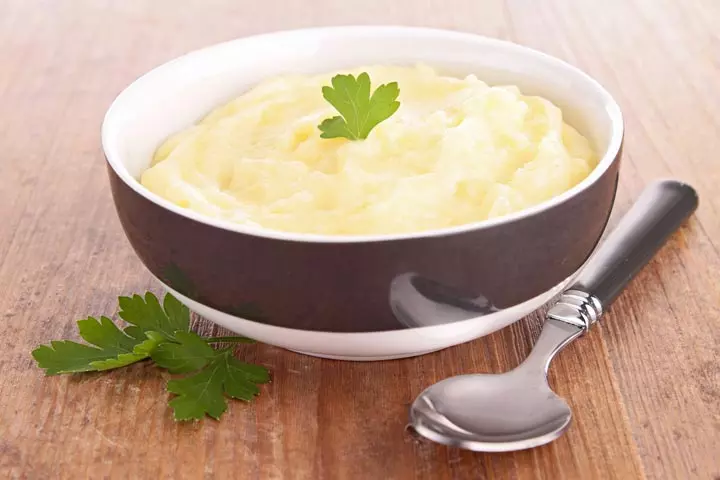
Turnip puree is prepared from a steamed or cooked turnip for young babies who cannot chew.
You will need:
- 2 baby turnip bulbs
- 1 cup water
- 1tsp jaggery powder (optional)
How to:
- Steam or cook the whole baby turnip bulbs. Steaming the turnip well will take approximately 20 minutes. Cooking can be done in a pressure cooker in three to four whistles.
- Put the pieces of cooked turnip in a blender, add some water, and blend.
- Blend until you get a smooth paste. Adjust consistency by adding more water or a small amount of breastmilk.
- You may add half a teaspoon of jaggery powder if needed.
- Serve it to your baby while still warm.
Tip: Once your baby gets comfortable with this new food, you may try adding some more vegetables to prepare a mixed puree. Some of the nutritious combinations to try are adding turnip to corn, apple, pear, carrot, or sweet potato baby food.
2. Turnip and lentil soup (8+ months)
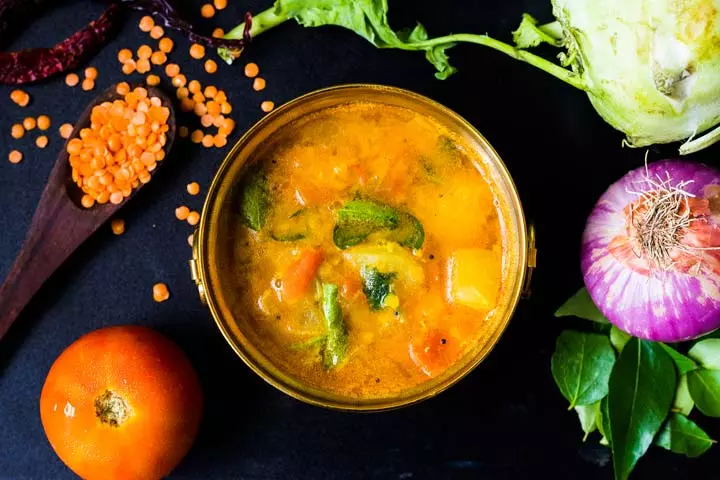
A vegetable soup with lentils is easy to digest and nutritious.
You will need:
- 1 cup red lentil
- 1 cup turnip bulb (cooked and mashed)
- ½ cup onion (diced)
- ½ cup tomatoes (diced)
- ¼ cup parsley (finely chopped)
- ½ tsp ginger garlic paste
- 1tbsp virgin olive oil
- Salt, to taste
How to:
- Wash the red lentils thoroughly and put them in a pressure cooker to cook. Cook up to five whistles. Keep aside the cooked lentil to cool.
- Take a thick bottom pan and put it on medium heat. Add one teaspoon of oil to it.
- As the oil heats, add onions and ginger-garlic paste to it.
- Fry the onions until they turn golden brown. Add tomatoes and salt, and let the mix cook until the tomatoes turn soft and mushy.
- Once tomatoes are cooked, add lentils and mashed turnips to it. Cook everything for seven to eight minutes. Switch off the flame and let the mix cool.
- Once cool, transfer the mix into a blender and blend into a smooth paste. Add water to adjust consistency. The soup should be smooth and flowy.
- Garnish the prepared soup with finely chopped parsley and serve it to your baby while still warm.
Tip: You can add seasonal vegetables with roasted herbs and seeds powder to intensify the nutritional value of the recipe. Check for any possible allergies if you are adding herbs and seeds for the first time.
3. Baked turnip crisps

You can add baked food items to your baby’s diet during baby-led weaning.
You will need:
- 3-4 baby turnips
- 4tbsp virgin olive oil
- 1 cup Parmesan cheese (finely grated)
- ¼ tsp pepper powder
- ½ tsp mixed herbs or herb mix
- ½ tsp salt
- Two sheets of baking paper (parchment paper)
How to:
- Preheat the oven to 420°F (215°C).
- Slice the baby turnips into thin slices. Keep the slices as thin as possible to make them crispy.
- Once done, take a large mixing bowl. Put the sliced turnips, olive oil, herb mix, and salt into it. Check that all the slices are evenly coated with salt, herb mix, and oil.
- Place the baking paper sheets on the baking tray. Place the turnip slices in a single layer on the baking sheets. Keep at least a quarter-inch distance between two slices.
- Put the baking tray into the oven and bake for 30-35 minutes.
- Turn the turnip slices in between to ensure they cook evenly from all the sides. Once they look golden brown and evenly cooked, take them out of the oven. Let them cool.
- Before serving, sprinkle pepper powder and Parmesan cheese.
Tip
: You can mix turnip crisp with some other vegetable crisps and make a fun bowl of crispies. It is a good idea to serve these crisps with homemade hummus instead of ketchup to intensify the overall nutritional value of the meal.
4. Creamy turnip greens with tofu (12+ months)
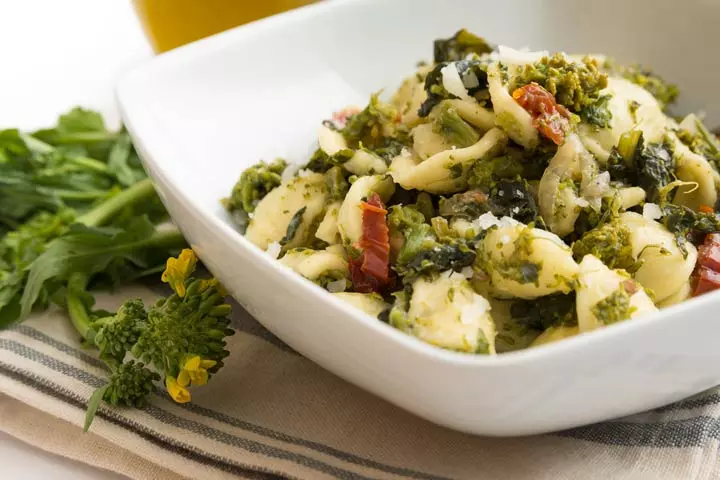
This recipe is ideal for babies once they begin to chew.
You will need:
- 2 sets of turnip greens
- ½ cup coconut milk
- 100g plain tofu (small cubes)
- 1 cup onion (finely chopped)
- ½ tsp black pepper powder
- ½ tsp salt
- 2 cup water
How to:
- Wash the turnip greens thoroughly in the large bowl. Ensure no dust, dirt, or grit is left on the surface of the leaves and their stalk.
- Chop off the tough stems and discard discolored leaves.
- Roughly chop all greens and keep them aside in a bowl.
- Take a stock pan and add a tablespoon to it. As the oil heats, put onions in the pan and saute them until they turn golden brown.
- Add tofu cubes and saute till tofu cubes also turn light brown from both the sides.
- Add turnip greens, salt, and a half cup of water into the pan.
- Let the greens cook with the lid covered. Once done, add coconut milk to the pan and let the mix come to a boil.
- Switch off the flame and let the mixture cool.
- Serve it to your baby or toddler with freshly baked garlic cornbread.
Tip: You can make this recipe with turnip bulbs, fish, pork, and chicken as well. However, while you try to experiment with the recipe, check for proper instructions while cooking for babies.
5. Turnip and sweet potato mash (6+ months)
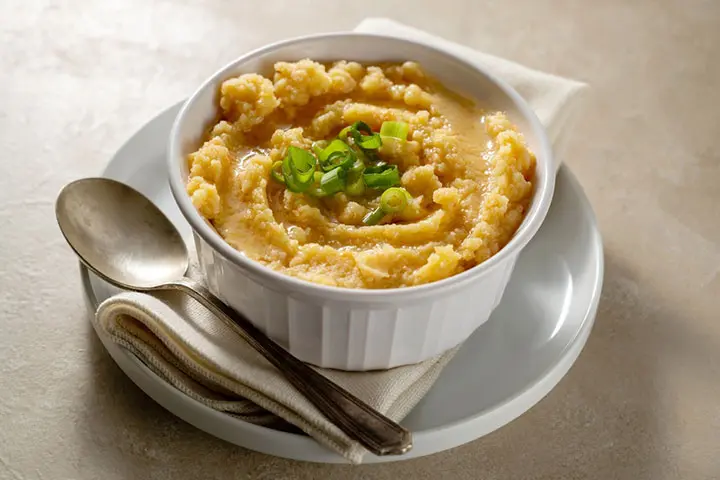
This sweet and nutritious mash is suitable for babies starting solids.
You will need:
- 1 cup turnip (peeled and chopped)
- 1 cup sweet potato (peeled and chopped)
- Water for steaming
How to:
- Steam the turnip and sweet potato until soft.
- Mash the steamed vegetables together until smooth.
- Serve warm.
Tip:
For a thinner consistency, add a little breast milk, formula, or cooled boiling water.
Frequently Asked Questions
1. Can turnips be given to babies with eczema?
While turnips are typically safe for infants, consulting a pediatrician or registered dietitian is recommended before introducing new foods to a baby with eczema.
2. Can turnips be given to babies with a history of diarrhea, vomiting, and colic?
Introducing turnips to the baby will depend on the underlying cause of past diarrhea, vomiting, or colic occurrences. Most babies with such a history can eat turnips without any problems. Nevertheless, do consult the baby’s pediatrician first.
3. Can turnips be given to babies with a history of picky eating?
Yes, while turnips do not reduce picky eating, they can enhance a well-balanced diet, ensuring the baby gets nutrients from turnips that they may be missing out on by not eating other food items.
Turnip is one of the most nutritious vegetables for babies as it has micronutrients and fiber. Its nitrate and nitrite content provides several health benefits. You may consider turnips for your baby when they start eating solids. It will help them have a good bowel movement, enhance iron absorption, and improve bone health. You may introduce turnips in the form of delicious recipes, such as turnip puree and turnips chips. Ensure the turnips are small and fresh with a mild sweet taste. Keep the quantity moderate, as excess might cause gastrointestinal disturbances and allergies.
Infographic: Safety Measures For Feeding Turnips To Babies
Turnips are a healthful and nutrient-dense addition to your baby’s diet, but if consumed excessively or improperly, they can cause allergic reactions and flatulence in babies. Check out the infographic below to learn about a few things to consider while introducing turnips to your baby’s diet.

Illustration: Momjunction Design Team
Learn to prepare a delightful and nourishing turnip puree, ideal for your little bundle of joy! Discover the simple recipe for this nutritious baby meal, suitable for infants aged 7 months and above.
References
1. Introducing Solid Foods; UW Health
2. Norman G Hord, et al.,Food sources of nitrates and nitrites: the physiologic context for potential health benefits; Oxford University Press
3. Nitrate/Nitrite – ToxFAQs; Centers for Disease Control and Prevention
4. Turnips, cooked, boiled, drained, without salt, 1 cup, mashed; University of Rochester Medical Center
5. Feeding and nutrition of infants and young children; WHO
6. Choline; National Institute of Health
7. Turnip; Kansas State University
8. Fiber Content of Selected Vegetables; NCBI
9. ShailjaChambialet al.,Vitamin C in Disease Prevention and Cure: An Overview; NCBI
10. Sachi Tanaka et al.; Changes in Gut Microbial Ecology and Immunological Responses of Mice Fed the Insoluble Fraction of Brassica rapa L. that was Fermented or Not; NCBI
11. Paul S,et al.,Phytochemical and Health-Beneficial Progress of Turnip (Brassica rapa).; NCBI
12. Dias C,et al.,Antimicrobial activity of isothiocyanates from cruciferous plants against methicillin-resistant Staphylococcus aureus (MRSA).; NCBI
13. Celso Pereira,et al.,Allergy Net: Turnip and zucchini: new foods in the latex‐fruit syndrome; Researchgate
14. Allergy to turnip greens; Journal of Allergy and Clinical Immunology
15. Turnip; EWG
16. Choline : an essential nutrient for public health; National Library of Medicine
17. Cruciferous Vegetables; Oregon State University.
Community Experiences
Join the conversation and become a part of our nurturing community! Share your stories, experiences, and insights to connect with fellow parents.
Read full bio of Cari Riker
Read full bio of Swati Patwal
Read full bio of Rohit Garoo
Read full bio of Ghazia Shah





